The Dribble-Drive Motion Offense - Running the Offense
By Dr. James Gels, From the Coach’s Clipboard Basketball Playbook"Helping coaches coach better..."

The dribble-drive motion offense is a popular motion offense that utilizes guard dribble-penetration as the key to creating offense. It is has been used by many college, pro, and high school teams. For the details and rules of the offense, see "Dribble-Drive Motion Offense".
This article adds examples of actions and ideas on how to run the offense. There are many options, but mainly it's teaching your players the basics and rules of the offense, and then "letting them play".
This is a 4-out guard-oriented offense that features spreading the floor for dribble-penetration for lay-ups or kick-out 3-point shots. The post player stays on the weakside for better spacing to maintain open lanes for dribble-penetration. There is little screening because screening sometimes clogs the gaps. But you can add ball-screens.
Now let's look at some actions and offensive flow.
Off the break - transition
As the ball is brought up the court, O5 is opposite and O2 and O4 are deep in the corners. This gives O1 the first chance to attack with the dribble-drive. O1 has the options of finishing the lay-up, dumping it to O5, or passing outside to O2.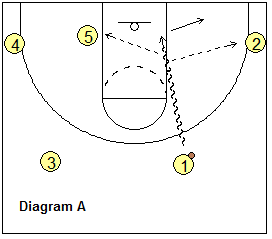
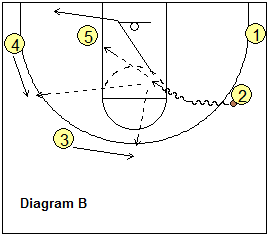
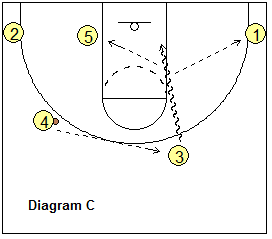
In diagram B, O2 has received the pass and could shoot the spot up 3-point shot. O1 moves out to either corner. O2 also looks to attack with the dribble-drive for a shot or lay-up, a dump pass to O5, or a kick-out pass out to the perimeter. If the ball goes to O4 (diagram C), O4 could pass to O3. Here we have continuity as O3 starts the whole motion scheme over again.
Let's back up to where O4 gets the ball on the skip out pass from O2 (diagram B). Instead of passing out to O3 (as seen in diagram C), O4 could dribble-drive (diagram D) and score, or kick a pass back outside.
If the ball is passed out on top to O3 (diagram E), O5 moves to the opposite low block, O4 moves through to the opposite corner, and now O3 attacks the left seam, a mirror of attacking the right seam above (diagram A).
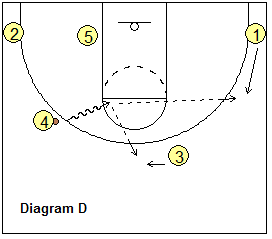
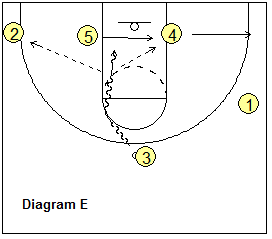
Dribble-Left Entry
If the X1 defender is over-playing O1 and denying the dribble into the right seam, O1 dribbles left (diagram F). O3 circles behind for the kick-back pass (the "kick-back" pass is not the same as a weave screen as there is 6-8 feet of space between the two players). Now O3 attacks the right seam (diagram G), while O1 pops back outside.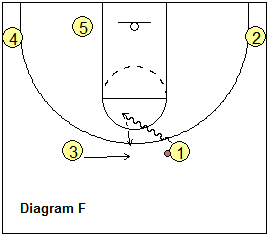
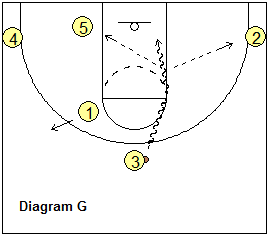
Opposite Guard Cuts First and Back-Cut Option
To give things another look, O3 cuts diagonally first, and then pops out to the opposite top guard spot (diagram H). O1 dribble-penetrates behind O3's cut into the left seam. O4 is in the corner for the kick-out pass from O1, and O5 moves opposite.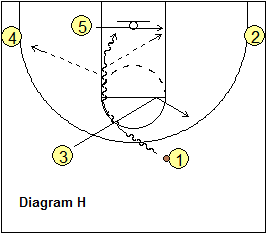
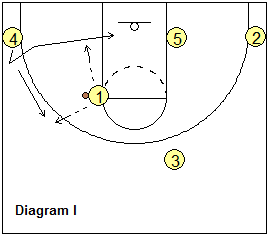
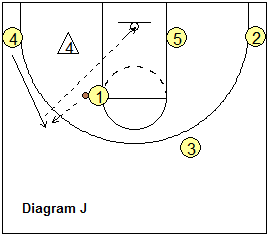
Here O1 is stopped at the elbow area ("drop zone"). If O4's defender is overplaying (denying the pass), O4 back-cuts from the corner (diagram I). Alternately, O4 moves up for the "kick-up" pass and possible 3-point shot (diagram J). Often the X4 defender drops inside to help on O1's dribble-penetration, and this leaves O4 open for the 3-point shot.
Wing Pass Entry with O2 in the Corner
In diagram K, O1 dribbles right and passes to O2 in the corner. A rule is "when you pass, you must cut". So O1 cuts through to the opposite corner, and O4 and O3 rotate up and over. O2's options include a 3-point shot, or a dribble-drive either baseline or into the top seam.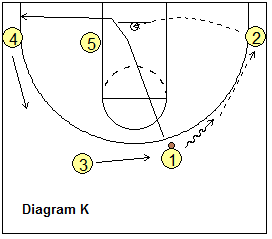
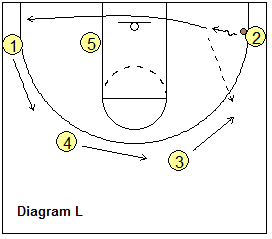
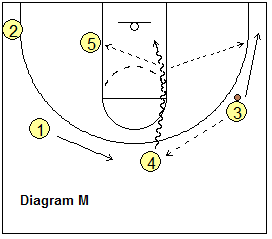
In diagram L, O2 dribbles baseline but there is nothing there and passes back out to the wing (O3). O2 cuts through to the opposite corner while O1 and O4 rotate. O3 passes to O4 on the top and re-locates to the corner (another rule: "wing pass to the top, the wing player slides down to the corner"). Now O4 attacks up the right lane seam (diagram M).
Wing Pass Entry with O2 up on the Wing
In diagram N, again we see the wing entry pass to O2. This time, O2 is higher up on the wing and O1 cuts to the ball-side corner. O2 could shoot the 3-pointer or dribble-drive into the top seam (diagram O).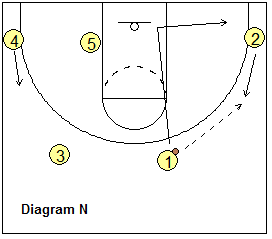
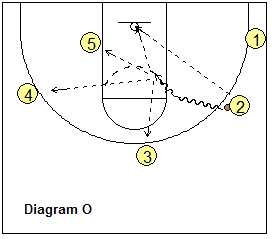
Wing Dribble - Weave Entry
O1 dribbles into the right seam (diagram P) and makes the kick-up pass to O2 moving up. O1 fills O2's original spot. O5 moves to the right side. O2 dribbles again into the top seam. O2 could shoot, dump pass to O5, or kick out to O4 or O3 (diagram Q).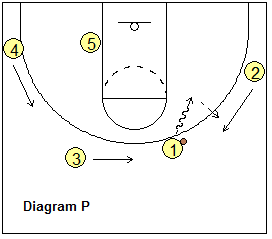
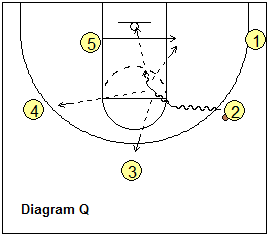
Weave-like Pattern
We can run a weave-like action with O1, O2 and O3, as seen the diagrams below. This is not s true old-style "weave" which uses weave-screens. In the dribble-drive offense, we maintain 6-8 feet between the passer and receiver.O1 dribbles toward the right seam (diagram R) and passes to O2 moving up top. O1 fills O2's original spot. O3 moves to the top. O2 dribble-drives intothe top seam (diagram S), but when stopped, passes back out to O3 and moves to the O3's left wing spot.
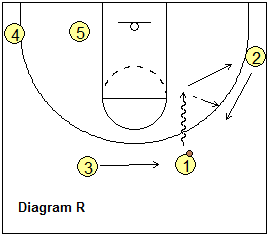
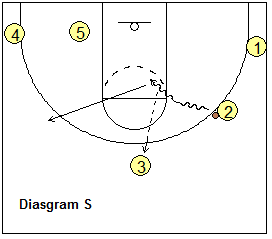
O3 now attempts to dribble-drive into the right seam (diagram T). When stopped, O3 passes back out to O1 and replaces O1. Finally, in diagram U, O1 is able to break down the defense and attack the top seam, for a lay-up, dump pass to O5, or a kick out pass for the 3-pointer.
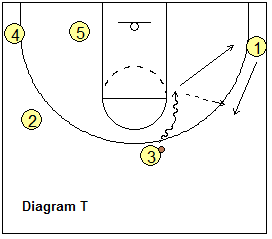
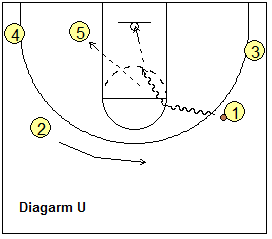
This weave action could go on indefinitely until one of our perimeter players finally breaks down the defense. Or could end with the very first dribble attack.
Related pages:
- Dribble-Drive Motion Offense
- Dribble-Drive Motion Offense Drills
- Dribble-Drive Set Plays
- Dribble-Drive Zone Offense